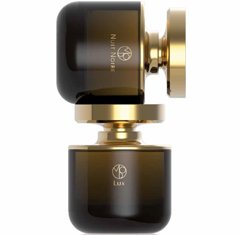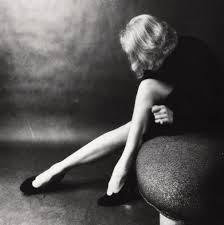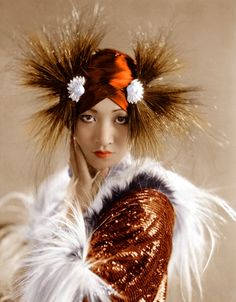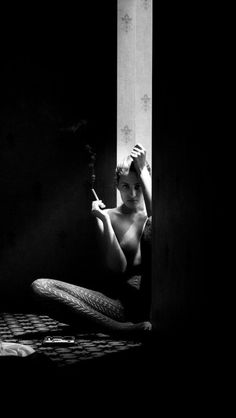Mona di Orio Chiaroscuro (TSF)
Chiaroscuro – from Italian – Chiaro ‘clear’, ‘bright’, (From Latin clārus – clear) + oscuro (Latin, dark, obscūrus)
Over the past few years we have written extensively on the tremulous visionary work of Mona di Orio, the sublimely talented young perfumer whose light was cruelly extinguished during routine surgery in December 2011 at the age of just 42. I was born in the same year as Mona and was therefore the same age when she died. I felt the loss very oddly; I had been wearing her fragrances for a while – Carnation, Chamarré, Nuit Noire and the day I heard she was gone, in my head a golden flickering candle was engulfed by shadow in a lacquered room.
Maison Mona di Orio Lux and Nuit Noire
Her partner Jeroen Oude Sogtoen was left behind to pick up the scented pieces and somehow move forward, carrying not just an immeasurable sense of personal grief but also the weight of expectation. Where does a House go when its muse dies? The answer unfolded with dignity and tremendous beauty last year as Maison Mona di Orio revealed it’s olfactory future watched over it seemed by the gauzy, haunted presence of Mona herself. Jeroen, as Creative Director re-branded beautifully, exquisite new flacons, enigmatic sensuous marketing and a brand new perfume called Myrrh Casati, the first by a new perfumer, Melanie Leroux to be launched by the house since Mona’s death. The architectural integrity of the Nombres d’Or collection will stay and be reissued in the new bottles and the Signature Collection will see some (perhaps not all) of the older scents return to light of day. For now it is Lux and Nuit Noire, both originally from 2006, also housed in the gorgeous Ateliers Dinand smoky oval flacons.
Marlene Dietrich 1952 chiaroscuro lighting
One of the leitmotifs to Mona’s oeuvre has been her use of chiaroscuro. This painters’ technique of tenebrism concerns the treatment of light and shade or genuine darkness on canvas to focus illumination on a particular theme or protocol. By muting background tones, flaring and flickering foreground and reflective light, luminosities can be altered, revealed and masked. By applying this artistic technique to perfumery, Mona di Orio combined her fifteen-year apprenticeship under Edmond Roudnitska with an unerring and razor-sharp attention to the natural luminosity of perfumed effects.
Anna May Wong Shanghai Express
Lux and Nuit Noire are appropriately enough the study of citric clarity and animalic darkness. Lux is a bright, white liquid of piquant lemony charm. Litsea cubeba or mountain pepper as it sometimes known is a beautiful note, lifted and lit by a triptych of bigarade, lemon and petitgrain. Despite the distinctive Italianate glare of these materials, a deeply grassy vetiver notes introduces a Thai broth-like effect over cedar and vanilla. My skin smells of aromatic Thai basil, lemongrass and green chilli, shot through with sweet sun-kissed Mediterranean citrus. It’s a disconcerting effect, a sultry, tropical tone leading languidly into the smooth benzoin/amber infusion in the base. Lux plays with degrees of light, contrasting tones of yellow, orange and white with green, woody umbers and vanillic ochre. The result is both contradictory and satisfying. A spiky citrus perfume with lambent verdancy.
Pinterest Photo: "Lucid"
Nuit Noire is the other side of the mirror, powdered night, a primal scent roaming the edges of a darkened room, searching for skin that might just be willing to submit. I used to love this scent to death and then it was gone. I am very pleased to say it smells exactly the same as I remember, so much so that I had to sit down upon sniffing it again; such was the velocity of memory. I am always struck by the intense spicy soapiness of the initial opening salvo of orange blossom and cloves. This indolic eugenol whammy is very unsettling and accompanied by ginger, cinnamon and a decayed tuberose thing just stuns and disturbs me. Nuit Noire is not pretty perfume; it is a scent of hoodoo, shadows and whispering menace. Aptly for a resurrected scent, I feel sometimes it smells of the dead, embalmed, anointed raiment, dust and ancient history. There are threads of gold and sadness clinging to the animalic reek of spice and rutting bouquet.
Edmond Roudnitska,Cabris, 1969 courtesy of Michel Roudnitska
In the end it all returns to chiaroscuro and Mona’s obsessive treatment of shadow, light and intricate olfactive interplay. She saw spaces between notes and gilded them. Her deliberate and detailed training in Cabris for 15 years with Edmond Roudnitska inculcated in her a very particular way of viewing the world and therefore the materials within it she gathered and formulated in her unique work. I am always moved by the ingenuity and surprising comfort of Mona’s work.
Rembrandt Lucretia Chiaroscuro
As I lived again with these two very different fragrances and their differing facets, I looked at the work of Rembrandt, the master of painting chiaroscuro. His work can move me to tears; such is the humanity and pain on show in fleck of paint and textured light. For me, his finest work is ‘Lucretia’ from 1666, an astonishing study of anguish, sacrifice and pain. It is also a masterly exercise in the art of chiaroscuro, the tragic mood of the painting played out in planes of shimmering tonal subtlety.Lucretia was a Roman noblewoman whose war campaigning husband boasted of his wife’s excessive virtue. A brutal Princeling decided to test this and returned to Lucretia and threatened her with rape. If she did not acquiesce, he would kill her and a slave and leave their naked bodies to be found together. She is raped and then later confesses this terrible act in front of her husband and father. Rather than live with dishonour, Lucretia chooses to die with honour and commits suicide. Most paintings depict the act of rape itself. Rembrandt does not do this. He depicts the truly appalling moment Lucretia has withdrawn the knife from her breast and waits, stricken and pale as her life force soaks into her garments and she begins to die. Lux, the purity of her virtue, a single pearl earring catches the light, just a simple piece of white pigment. Lucretia’s hand clutches at a rope, almost to support herself as the shadows of night close in. Her simple shift is white, stained a shocking waterfall of crimson, the rest is muted gold, glittering sadly against the darkness like protection. This dramatic and harrowing painting is the embodiment of light and dark, lux vs noir. One has need of the other. Since Mona’s premature death, one cannot help imbuing reviews and observations on her work with a certain sense of morbidity and sadness, yet her work contains joyous sparkling luminescence but also the opposing shadow for correction and balance. This is how it should be. Welcome back Lux and Nuit Noire, we have missed you.
Disclosure – Samples kindly provided by Maison Mona di Orio
The Silver Fox, Senior Editor and author of The Silver Fox
Note: Editor in Chief Michelyn Camen was one of the last journalists to interview Mona, a few months before her untimely passing. You can read that interview here
Thanks to Jeroen Oude Sogtoen we have a reader’s choice worldwide of either Lux or Nuit Noire. To be eligible please leave a comment with your favorite Mona Di Orio Perfume, the fragrance you would like to win and where you live. Draw closes 1/29/2015
We announce the winners only on site and on our Facebook page, so Like Cafleurebon and use our RSS option…or your dream prize will be just spilled perfume







